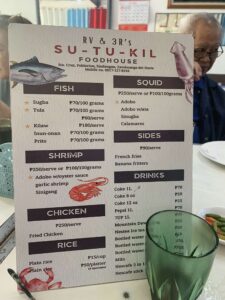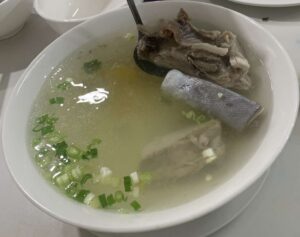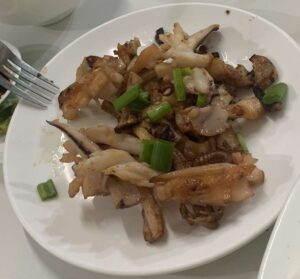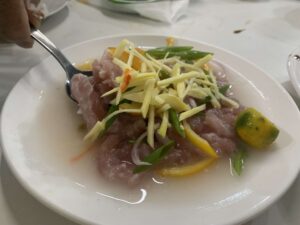Su – Tu – Kil Foodhouse, Zamboanga del Norte
Photos and Text by: Nonnette C. Bennett
The striking name of the restaurant, Su – Tu – Kil, would get cautious curious eaters on cuisine in this diner a little queasy. What’s in the name? This actually stands for three ways of cooking in the Visayan language — sugba or grill, tula or boiled, and kilawin or raw fish slices in vinegar and coconut milk.
We were on the road for six hours from Zamboanga City, and this was a popular restaurant in Sta. Cruz, Poblacion, Sindangan, Zamboanga del Norte. Quite like the restaurants at the Slaughterhouse Compound in Baguio City, the tables in this restaurant were long and shared, which was perfect for the 22-strong contingent of tourists to occupy on one side from Baguio and Manila venturing to Dakak, Dipolog City. A perfect set of grilled fish, fish in sour soup, raw fish in vinegar and coconut milk, and fried squid were set for four persons in the long table. Our lonesome server was efficient in setting the plates, cutlery, bowls, sauce dishes, and glasses on the long table as we waited some 30 minutes for the meal service.
If I am not mistaken, the fish was maya maya because there was a tinge of red on its body. This was grilled to perfection to keep the meat moist and juicy. The head was well done with the flesh on the cheeks and head flaky and soft. The belly was stuffed with an herb that was like lemongrass, and this removed the bitter and fishy taste of intestines. The meat was sweet and smooth.
The tuna chunks boiled in clear sour soup and onions were refreshing. This had a dominant lemongrass flavor and scent and a refreshingly clear broth. The onion leeks and tomato slices absorbed the fishy scent and taste of the tuna chunks in the soup. Of course the tuna is flaky and solid.
Raw tuna in vinegar and coconut milk topped with fine strips of fresh ginger, white onions, tomato strips, and onion leeks, was sweet and umami. The mix of white vinegar, calamansi juice, and the milky coconut juice brought out the smooth and silky texture of the uncooked thin slices of fresh tuna. This blended well with the grilled and boiled fish, adding a different texture to the meal. This melted in the mouth in its tenderness.
The fried squid was chewy and rubbery, but the freshness was undeniable. The meat was white and smooth on the inside as fresh squid is. Still on the sweet side, this was likewise perfectly fried with garlic and caramelized onions.
We were too curious about the one other item on the menu – inun-onan. We had to taste their version of tuna cooked in vinegar or what the Ilocanos and Tagalogs call paksiw. We were not disappointed with the chunks of fish in the subtly sour sauce with garlic and onions. The sweetness of fresh tuna was still remarkable.
The secret must have been in the rice that was aromatic and soft. We said that some villages still plant the traditional rice that stands out in its almost glutinous quality, while it smelled of pandan.
Late lunch was simple and perfect. Our Korean friend, David Moon’s eyes were popping out at the calculation of the cost of what we were eating in grams. He said that one kilo of what we were about to eat costed P1,000. But when he went up to watch the other table selecting and weighing the fresh fish to be grilled, particularly after he ate the fish and squid, he said it was worth it.
Su-Tu-Kil sounds scary, but it is truly an excellent way to prepare food.








